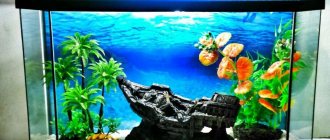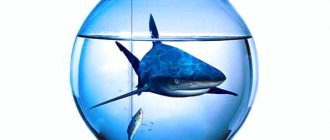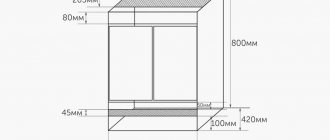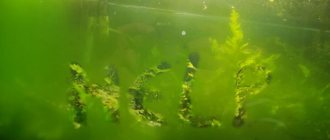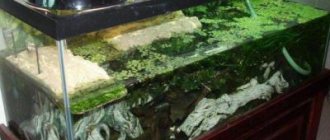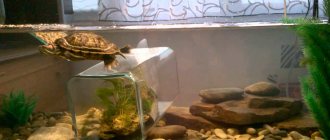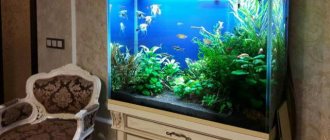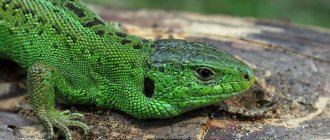The marine aquarium environment is much more complex than a freshwater system. Ordinary tap water must not only be left standing and sea salt added to it, but also initially completely cleaned of impurities.
Tap water does not meet the parameters necessary for maintaining marine aquatic organisms and tropical fish. The Lysmata online aquarium store offers a full range of products that will help create optimal living conditions for the inhabitants of the World Ocean.
Basic water parameters
Marine aquarium water standards include:
| Options | Required indicator |
| pH of the environment | 8,1–8,3 |
| Carbonate hardness | 7–11 dkH 125–200 ppm CaCO3 |
| Calcium | 380–400 ppm (mg/l) |
| Nitrates | <0.2 ppm (mg/l) |
| Nitrites | <0.2 ppm (mg/l) |
| Phosphates | <0.03 ppm (mg/l) |
| Magnesium | 1250–1350 ppm (mg/l) |
| Ammonia | <0.1 ppm (mg/l) |
| Salinity | 35 ppt (mg/l) |
| Temperature | 24–26 °C |
| Density | 1.026 g/cm3 |
To measure water parameters, the following instruments are required :
- refractometer (salinity and density);
- digital hydrometer (specific gravity);
- proprietary tests for measuring the concentration of microelements.
Substitution or complete replacement?
Every responsible aquarist replaces a third of the aquarium volume with fresh water once a week.
Replacing with tap water is quite acceptable if it has been prepared beforehand. As for a complete replacement, it should be done as a last resort. Since this undermines the biological balance, in fact, a complete water change is a restart of the aquarium with all the ensuing consequences, and it is no longer so important what water to fill.
Tap water should not be added to replace evaporated water, as this will affect the parameters. It is better to use osmotic or distilled water as a top-up.
Advantages and disadvantages
Before you start arranging an ecosystem, you should weigh all the pros and cons of this labor-intensive task:
| Advantages | Flaws |
| A memorable appearance as the main decoration of the interior. | High cost of equipment and maintenance. |
| A variety of options in the choice of inhabitants and elements. | Accuracy in observing water parameters and checking compliance using special instruments and reagents. |
| Possibility of coral breeding. | Labor-intensive process of water renewal. |
| Reduced need for frequent cleaning, unlike freshwater counterparts. | Providing the aquarium with proper filtration and aeration. |
| Possibility of earning income from the sale of fry. | Choosing a certain type of soil for arranging an ecosystem. |
One last note about aquarium salt
Salt is a supplement and a medicine. You need to be well aware of the purpose for which it is added and what will happen to the inhabitants of the reservoir after use. This element has supporters and opponents.
Each group has arguments for and against the use of salt mixes. If you are in doubt about whether salt should be added, contact your veterinarian, who will help identify the problem and prescribe a course and dosage if necessary.
Did you like the article? Not good? Then it is possible that you will write yours much better. Just follow the link Posting articles and read the rules for publishing articles on the MultiBlog67.RU website.
approximate cost
One of the disadvantages of marine aquariums is the high cost of high-quality equipment .
Approximate start-up costs:
| Product | Cost in rubles |
| Aquarium volume 200 liters (minimum) | 10000-12000 |
| Cabinet | from 5000 |
| External filter | from 12000 |
| Sea salt for aquariums | 250 /kg |
| Pumps for flow | from 2000 |
| RGB LED lighting fixture | 5000 |
| Micronutrient concentration tests | from 700 to 2000 |
| Hydrometer | from 800 |
| Electronic pH meter | 5000 |
| Fan | from 2000 |
| Micronutrient supplements | from 400 |
| Fridge | from 20000 |
| Heater | from 2000 |
| Living stones | from 1200/kg |
| Living sand | 250/kg |
For various aquarium equipment and decorations, prices may vary depending on the manufacturer .
Ingredient selection
To prepare the right water, you will need sea salt. You can buy it at any pet store. Table salt and sea salt intended for baths are not suitable. You only need the one that says “for aquariums.”
Preferred Brands:
- Red Sea is a natural product obtained by evaporating the water of the Red Sea. There are no additives.
- Res Sea Coral Pro - characterized by increased alkalinity, which activates the growth of corals. The price of the packaged product is quite high, so many pet stores offer this salt by weight. So its price comes out much cheaper.
- Prime - made from Mediterranean water. It has two forms of release - for marine and reef aquariums.
- Tropic Marine is a product of synthetic origin. The composition includes microelements that help create a favorable aquarium environment.
- Reef Sea Salt is a synthetic salt that contains iodine, calcium and magnesium.
Selection rules. Which type of salt to choose is a matter of individual preference for the aquarist. The main thing is that the product is of high quality and does not have chemical impurities.
Aquarium salts are sold in different weight packages. What volume of ingredient to choose depends on the size of the aquarium. The greater the amount of salt, the cheaper it will be in the end. Owners of aquariums of 200 liters or more are recommended to buy large jars.
Necessary equipment
Choosing an aquarium and equipment for its arrangement is a large-scale space for creativity.
When choosing the aquarium itself, you may be faced with the following options:
- Angular.
- Wall.
- Panoramic.
- Classic or rectangular.
- Carousel type.
Types of equipment
When choosing technical elements of equipment, you need to pay attention to the quality and lack of reaction to salt water.
Carefully! Oxidation of elements can lead to the penetration of toxins dangerous to organisms into the water.
To start the system you will need:
- mechanical filtration (carried out through padding polyester or foam rubber layers);
- biofiltration;
- chemical filtration (activated carbon);
- external filter;
- lighting (metal halide lamps, LED lamps, T5 lamps);
- fridge;
- adjustable heater;
- pumps (2 pcs).
Is it possible to pour salt directly into the aquarium?
Whenever you add salt, make sure it is completely dissolved before adding. Dissolve the mixture in a small container of water and then pour the salt water into the aquarium.
The granules burn the body on contact with fish and cause internal problems if waterfowl try to eat the undissolved salt, mistaking it for food. In addition, plants and fish without scales (catfish, tetras, neons) are very sensitive to salt levels. Do not use salt in an aquarium with algae and use it with extreme caution in aquariums with sensitive fish.
Step-by-step instructions on how to make the necessary salinity
Sea water is the basis of the ecosystem and an essential element of caring for exotic fish.
What will you need?
To make sea salt water you will need:
- sea salt from a pet store;
- reverse osmosis filter.
To prepare the water of a marine aquarium, it is necessary to use a reverse osmosis filter , the operating principle of which is configured to remove impurities and partially retain oxygen.
Important! When preparing salt water, you can only use specialized sea salt for aquariums, which can be purchased at pet stores.
Manufacturing process
After installing the reverse osmosis filter, you can begin preparing water for the aquarium:
- Water enters the pre-filter.
- Purified water goes through reverse osmosis stages inside the equipment.
- Clean water comes out through the tap and is used to accumulate in the tank.
- Add salt for marine aquariums (40g/1l).
It is necessary to purchase salt in reserve so that the fish always have access to renewed water.
Marine aquarium: a brief guide to creating the world
Introduction
Marine aquarium farming in Russia is still very poorly developed. There are few specialists, few amateurs. Only one book has been published in Russian (Stepanov D.N., 1994, “Sea Aquarium at Home”), and its circulation has long been sold out. There is an acute lack of information for those wishing to join. Having bypassed the question of “who is to blame?” for now, let’s try to immediately figure out “what to do?”
Since it is impossible to grasp the immensity in one single article, let’s hope that the inquisitive reader already has inanimate matter “in the form of” an aquarium, a set of equipment, chemicals... and is concerned with only one thing: how to perform a miracle - to breathe a living spark into this pile?
This instruction was initially written for our clients as the shortest possible answer to this burning question. However, for magazine publication, its dry text had to be somewhat diluted with “non-lyrical digressions” (aka UFOs), explaining the most problematic points.
Let us only recall that in modern aquarium farming there are two main types of marine aquariums that are most popular. The first one is intended mainly for fish. The second is reef - mainly for corals and other invertebrate animals that are particularly demanding on water quality and lighting.
So, let's begin
:
- Prepare decorative elements (
Scenery).
- Set up the aquarium, mount the main part of the decoration (do not fill the soil or lay down “live stones”), load it with fillers and connect (but do not turn on) the filters, ground the aquarium (see.
Chemical aggressiveness and electrical conductivity of sea water)
- Fill the aquarium with tap water to the usual level, let it sit for 6-24 hours and drain the water (attention: if chemically active substances are used to make the decoration and/or aquarium, the period of preliminary settling of the water should be increased).
- Fill the aquarium with fresh water to 3/4 (aquariums up to 200 l) - 4/5 (aquariums over 500 l) of its volume. As a rule, you can use tap water (water preparation). To remove chlorine ions and heavy metals, it is better to add an aquarium conditioner (for example, Tetra AquaSafe or Tap Water Conditioner) to it.
- Turn on the compressor, filters and thermostats. If there is an ultraviolet water sterilizer and/or ozonizer, do not turn it on!!! You can also leave the skimmer switched off for now. Leave the water to stand for a week, setting the temperature to 26°C.
- After the water has settled, if there was activated carbon in the filter, remove it or turn off the filter. Then add artificial sea salt to the aquarium at the rate of 37 grams of salt per 1 liter of water. Keep the water in the aquarium agitated using an air compressor and/or pump.
- In a separate container, prepare a solution of sea salt with a concentration 1.5-2 times higher than in the aquarium (55-70 g of salt per 1 liter of water) and a volume close to the amount of water that needs to be added to your aquarium to establish below the normal water level.
- Wait until the salt has completely dissolved and measure its density using a hydrometer in the aquarium and in an additional container.
- Use a siphon to collect sediment from the bottom of the aquarium. Fill in the soil. Complete the decorations (except for laying out the live rocks). By adding a concentrated solution and/or fresh water to the aquarium as needed, bring the level to normal and the density to 1'022-1'024 g/l.
- Leave the salt water for at least a week. Approximately in the middle of this period, connect the filter containing activated carbon and the foam separating column, add the first portion of the bacterial preparation (for example, Tetra Bactozym, Stress Zyme or Cycle - see also starting the biofilter) and/or add live stones."
- Check the density, pH and ammonium and nitrite content of the water. If the concentration of ammonium and nitrites is higher than 0.5 mg/l and/or pH is lower than 8.0, then the processes of decomposition of dead organic matter continue in the aquarium. You need to try to find and remove its source from the aquarium. Decomposition can be accelerated by temporarily increasing the water temperature to 33°C and/or adding special preparations (for example, Tetra Bactozym or Waste Controll).
- If the water indicators are normal, then after bringing the water temperature to 26°C, you can add the first fish to the aquarium (introducing fish into a marine aquarium).
- Prepare fresh seawater in a separate container for the change.
- The most alarming stage begins. The bacteria that process fish waste have not yet colonized the biofilter, and the water quality is rapidly deteriorating. It is necessary to monitor the situation by measuring ammonium and nitrite levels daily. The process of starting a biofilter is described in detail in starting a biofilter.
- After the content of ammonium and nitrites drops below 0.5 mg/l, you can begin to gradually introduce new fish - no more than once a week, with constant monitoring of water quality.
- If the last fish are added to the aquarium, and the concentration of ammonium and nitrites is consistently below 0.1 mg/l, you can be congratulated - the “start-up period” has been successfully completed. Although the final biological balance will be established only after 3-5 months.
- If the equipment includes an ultraviolet sterilizer or ozonizer, you can turn them on (the ozonizer should be used very carefully, only if you are well versed in the methods of its use).
To the begining
Non-lyrical digressions (UFO):
UFO 1. Decoration
Natural marine objects are often used to decorate marine aquariums. However, often sea rocks with remains of algae, dead shellfish, etc., shells (especially large ones), natural dead corals (to a lesser extent) and other similar materials may contain too much dead organic matter. It is better to mechanically clean such decoration elements first (it is not advisable to use metal brushes). If this is not enough, you can place them in a container with water, ensuring that it is changed periodically, at a temperature of 30-35°C and blown with air. Use only after the unpleasant odor disappears. Corals are sometimes bleached with bleach or boiled in a solution of calcium hydroxide, then washed and soaked in fresh water.
Live rocks ”
), collected or broken from the surface of a coral reef and delivered to us in a wet state, in such a way that algae, animals and microorganisms are preserved on their surface and inside the numerous pores and openings. They can bring your home aquarium as close as possible to the real coral reef ecosystem. At the same time, you can bring new residents into the aquarium that are dangerous for your pets. In addition, no matter how carefully these stones are collected and transported, a significant part of their inhabitants die. If you place a lot of freshly received stones into the aquarium at once, the water in it will be spoiled.
The stones are first cleaned of dead organic matter, then placed in a separate container with sea water, good lighting (day cycle) and aeration. Then it is kept with daily water changes - it is better to leave this to the specialists of your store.
To the begining
UFO 2. Chemical aggressiveness and electrical conductivity of sea water
Water in general is one of the most mysterious substances, and sea water in particular. Actually, H2O makes up only 96% of its weight. It dissolves inorganic salts and gases, organic substances, and also contains various microorganisms. This “compote” is very aggressive; for example, most grades of stainless steel rust well in it, and aluminum and bronze corrode. And many marine aquarists have bad memories of how sea water conducts electricity.
Accordingly, everything that comes into contact with water (decorative elements, equipment, etc.) must be made of chemically neutral materials. No metals except titanium! The only thing that can be allowed to some extent (but not for a reef aquarium) are pumps and pompofilters with stainless steel rotor rods.
In addition, the air above the water in a saltwater aquarium contains tiny droplets (mostly from bursting air bubbles). When they settle on hard surfaces and dry out, they leave behind salt crystals, which often quickly contaminate lamps and cover slips. When wet, this salt “fouling” corrodes metal parts (rust can leak into the water) and conducts electricity in the wrong places. You and your aquarium must be prepared for this.
I highly recommend grounding the akarium by placing the titanium electrode so that it is always lowered into the water. An electrician must connect the ground.
To the begining
UFO 3. Preparation of fresh water
As a rule, when keeping marine fish, you can use tap water, but not always. Too high a content of iron salts results in a yellowish color of the water and rusty streaks on the plumbing fixtures. The easiest way to reduce the concentration of iron is to let the water sit with medium aeration and carefully get rid of the sediment.
Sometimes tap water contains nitrogen compounds - ammonium, nitrites and nitrates. It is better to use only water in which ammonium and nitrites are not detected by appropriate aquarium tests (i.e. their concentrations are below 0.1 mg/l), and the nitrate content does not exceed 5-10 mg/l (see also starting a biofilter) . Natural spring water is often highly mineralized and may contain impurities that are undesirable for a marine aquarium.
Especially often, problems with water arise in suburban cottage villages with individual artesian water sources; in this case, we strongly recommend that you conduct a full chemical analysis of tap water in a specialized organization (Sanitary and Epidemiological Station, Vodokanal...) - after all, you drink it.
If you have drinking water filters of sufficient capacity, it is better to use them (except for those that actively saturate the water with silver ions).
When tap water is not suitable, you must either bring the required amount of water from a good water source or use deionized (distilled) water. It can be prepared directly inside the aquarium or water change container. To do this, place in an aquarium filled with tap water a column with ion exchange resins specially designed for aquarium farming (for example, “Tap Water Purifilter”) with a pressure pump connected to it. The best results are achieved with a low flow rate of water through the column. The operating time of the column should be sufficient for the entire volume of water to pass through it several times. Of course, the performance of the ion exchange column must correspond to the volume of the aquarium.
To obtain deionized water, you can also use reverse osmosis units - for example, Aqua Medic Standard. However, they require connection to a water supply with a water pressure of 4 (from 3 to 6) atm. and constant monitoring during work.
The most traditional use of distilled water. However, purchasing it and transporting it in the required volumes can cost you a lot. Production at home using a distiller is not very convenient and requires a lot of electricity.
For reef aquariums, it is imperative to use deionized water. The easiest way to check its quality is with an aquarium test for general hardness - it should be close to zero.
To the begining
UFO 4. Planting fish in a new marine aquarium
When planting fish and/or invertebrate animals in a new marine aquarium, it is necessary to be very careful, since the bacteria that purify the water have not yet settled in its biofilter in sufficient quantities (starting the biofilter).
You need to start with a minimum number of animals. The species most resistant to high levels of ammonium and nitrite are planted first. (Ehidna nebulosa, Gymnomuraena zebra...) cope better with these problems than others.
), groupers (
Cephalopholis miniatus, Cromileptes altivelis, Variola louti...
), yellowtail (Abudefduf saxatilis), yellowtail (Chrysiptera
parasema
), zebra dascyllus
(Dascyllus aruanus
), yellow zebrasoma (
Zebrasoma flavescens
), as well as crabs and hermit crabs (
Pagurus sp., Dardanus sp…
).
As a last resort, you can use less resilient ones - black-striped zebrafish (Zebrasoma veliferum
), triggerfish (
Odonus niger, Rhinecanthus sp...
), sapphire chrysiptera (
Chrysiptera cyanea
), large species of clownfish (
Amphiprion melanotus...
), lionfish (
Pterios volitans and P .miles
) and some others.
It is possible to increase the population of the aquarium only after the biofilter is working steadily. Those fish that are the first to settle in the aquarium will consider themselves its masters and may treat subsequent settlers too harshly. Therefore, the order of planting fish must be arranged taking into account their size and aggressiveness.
To the begining
UFO 5. Launching the biofilter
During the life of fish and during the decomposition of organic substances, very toxic ammonium (NH3/NH4+) is released into the aquarium water. Nitrosomonas bacteria are capable of oxidizing it to nitrites (NO2-), which are also very poisonous. Nitrobacter bacteria, in turn, oxidize them further - to nitrates (NO3-), which fish can tolerate in concentrations hundreds of times higher than ammonium and nitrites.
The biofilter of your aquarium is specially designed so that these bacteria can live and work well in it. The greater their number lives in the biofilter, the more water passes through it, and the higher the oxygen content in it, the better its cleaning ability.
In a new saltwater aquarium, the biofilter is still sterile and does not contain the necessary bacteria. However, they are very common and will penetrate into the aquarium through the air, as well as with decorations, etc.
We can also push the process forward by adding a special bacterial preparation to the aquarium, adding live rocks or dead, untreated corals. After you have added the first fish to the aquarium, the concentration of ammonium begins to increase, because its consumers are still almost absent. However, once there is enough “food”, the still few Nitrosamonas bacteria begin to multiply. The more there are, the more successfully they cope with ammonium entering the water. The growth of its concentration slows down, and then it begins to fall. At the same time, as a result of ammonium processing, nitrites appear in water. Only now are conditions created for the growth of Nitrobacter bacteria.
While the ammonium concentration tends to zero (i.e. bacteria manage to immediately process all the ammonium entering the water), the amount of nitrites increases - history repeats itself. New bacteria are gradually “breaking” the situation. Now nitrites are disappearing, giving way to nitrates. But they are not scary for us yet.
Typically, the biofilter maturation process takes four to six weeks. (See picture)
Living stones with their rich microflora help to achieve biological balance faster and easier. It is best to place crushed live rock directly into the filter. The most obvious way to speed things up is to add already “started” bacteria-infested substrate from an existing aquarium into the biofilter. However, the risk of introducing fish pathogens is very high.
In any case, when adding a filler that already contains bacteria, it is better if its volume is at least 10% of the biofilter volume. It should be laid so that the flow of water first passes through it and then falls on the fresh filler.
The addition of bacterial preparations (for example, Tetra Bactozym, Stress Zyme or Cycle) usually does not greatly accelerate the maturation of the biofilter. But it allows you to reduce peak concentrations of ammonium and nitrites. Provided, of course, that the drugs are of high quality and not spoiled during storage and transportation (for example, they cannot be frozen).
Normally, the concentration of ammonium and nitrites when keeping marine fish should not exceed 0.1 mg/l, and for nitrates - 30 mg/l (many people easily tolerate 50-100 mg/l, and some even more than 300 mg/l ).
As a rule, fish are able to withstand ammonium or nitrite concentrations reaching 1-1.5 mg/l for three to four weeks. Although this reduces immunity and increases the risk of disease. Concentrations of 3-4 mg/l are already very critical, and it is better not to expose fish to them for longer than 3-5 days. Concentrations of 5 mg/l or more are deadly.
The simplest (but not the easiest) way to combat toxic nitrogen compounds is to change the water. Water for change should be well settled and aerated. Its temperature and salinity should be the same as in the aquarium. Freshly prepared water should only be used as a last resort.
Any water change is stressful for the fish. And you need to carry it out more carefully and slowly, the more water you change. If your aquarium is small (up to 150-200 l), then when the concentration of ammonium and/or nitrites increases to 1 mg/l, it is advisable to start replacing up to 10-15% of its volume at a time. And when their level reaches 3 mg/l or more, you will have to increase replacements to 20-30%.
In large saltwater aquariums it is usually not possible to replace such large volumes. At the same time, the concentrations of ammonium and nitrites increase more slowly in them. This means you have a better chance of not taking things to extremes. In addition, at critical concentrations of ammonium, you can use the drug “Ammo Lock 2”, which converts it into a non-toxic form. In this case, ammonium is not removed from the water, and is recorded by tests in the same concentration. It is not recommended to use this drug more than three times during the maturation of the biofilter.
Commercially available ion exchange resins for ammonium removal are generally designed for fresh water only (eg Ammonia Remover and Ceo Carb). Sometimes the biofilter is “started” without fish - on artificial feeding. To do this, they usually use special preparations (for example, “SuperCharger Aquarium Starter”), in addition, the bacteria can be fed with a piece of rotting fish or something like that, as well as by adding ammonium chloride. In this case, fish and other animals can be planted only after the biofilter has fully matured. Before planting fish, it is necessary to completely change the water. Therefore, it is better to connect the filter at this time not to the aquarium, but to a separate small container. Even with this technology, fish must be planted in the aquarium carefully and in several stages, since changing the water and changing the nature of the load at first will significantly reduce its cleaning ability.
To the begining
Conclusion
The “launch” of a new marine aquarium and its biofilter can be considered one of the most difficult problems in the marine aquarium hobby. We should also not forget that many people have to go through part of this difficult path more than once, since most methods of treating fish lead to death or a sharp decrease in the activity of biofilter bacteria. The author hopes that this article will help readers avoid many mistakes and save time and money. And when the difficulties are left behind, a newborn wonderful world will appear in your home - a particle of the distant ocean.
© 1998 Andrey Telegin © 1998 Aqua Logo
Inhabitants
Depending on the chosen flora and fauna, caring for the ecosystem and maintaining its condition may become easier (the presence of corals or mollusks as natural filters).
| The most popular living organisms in marine aquariums | |
| Fish | Fire Angel, Blue Tang, Yellow Zebrasoma, Clownfish, Royal Gram, Anthias, Frenatus, Dogfish. |
| Plants | Pinnate leaf caulerpa, Leaf caulerpa, |
| Invertebrates | Starfish (Asterodiscus red), Sea urchins, Jellyfish Eared aurelia, Tube worms. |
| Corals | Soft: Sea anemones, Stolonifera, Horn corals, Gorgonians. Hard: Madrepore corals, Scleractinia, Galaxea, Caulastrea, Lobophyllia, Tubastrea. Non-photosynthetic: Dendrophilia, Tubastrea, Scleronephthia. |
| Arthropods | Shooter Crab, Boxer Crab, Hermit Crab, Harlequin Shrimp. |
| Cephalopods | Nautilus, Octopus, Cuttlefish, Molluscs, Squid, Snails. |
| Elements | Live rocks, Dry reef rocks, Live sand. |
Peculiarities! The starfish can be dangerous to corals in a marine aquarium ecosystem. If signs of destruction (white spots) appear, you should get a natural enemy of the starfish - the harlequin shrimp.
Along with live rocks, you may accidentally acquire some unwanted living organisms :
- mantis crab;
- polychaete carnivorous worms;
- glass rose sea anemone;
- planarians.
There is no need to worry about infection by bacterial organisms, since they are food for living stones.
Is it possible or not?
The answer to this question can only be given after testing.
After all, without knowing the parameters, it is difficult to judge whether the water is suitable or not. But for unpretentious fish and simple plants, the use of tap water is almost always acceptable, the only caveat is the presence of chloride compounds in the water supply , but they are easy to get rid of.
There are many aquarists who manage to achieve not only successful keeping of fish in tap water, but also their reproduction.
Therefore, for most undemanding fish species, using tap water becomes the best option.
It is strictly forbidden to pour tap water directly into the aquarium! It should also be prepared before use.
